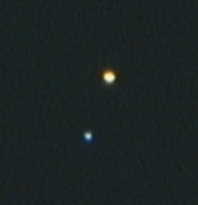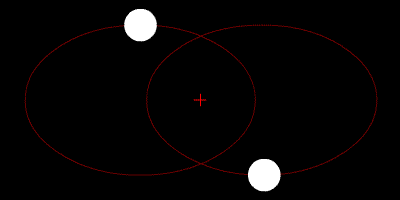Binary stars

A binary star is a star system consisting of two stars orbiting around their center of mass. For each star, the other is its companion star. Recent research suggests that a large percentage of stars are part of systems with at least two stars. Binary star systems are very important in astrophysics, because observing their mutual orbits allows their mass to be determined. The masses of many single stars can then be determined by extrapolations made from the observation of binaries.
Binary stars are not the same as optical double stars, which appear to be close together as seen from Earth, but are not bound by gravity. Binary stars can either be distinguished optically (visual binaries) or by indirect techniques, such as spectroscopy. If binaries happen to orbit in a plane containing our line of sight, they will eclipse each other; these are called eclipsing binaries.
Systems consisting of more than two components, known as multiple stars, are also not uncommon. The components of binary star systems can exchange mass, bringing their evolution to stages that single stars cannot attain. Examples of binaries are Algol (an eclipsing binary), Sirius, and Cygnus X-1 (of which one member is probably a black hole).
Designations[edit]
The components of binary stars are denoted by the suffixes A and B appended to the system's designation, A denoting the primary and B the secondary. The suffix AB may be used to denote the pair (for example, the binary star α Centauri AB consists of the stars α Centauri A and α Centauri B.) Additional letters, such as C, D, etc., may be used for systems with more than two stars. In cases where the binary star has a Bayer designation and is widely separated, it is possible that the members of the pair will be designated with superscripts; an example is ζ Reticuli, whose components are ζ1 Reticuli and ζ2 Reticuli.
Double stars are also designated by an abbreviation giving the discoverer together with an index number. α Centauri, for example, was found to be double by Father Richaud in 1689, and so is designated RHD 1.These discoverer codes can be found in the Washington Double Star Catalog.
Formation[edit]

While it is not impossible that some binaries might be created through gravitational capture between two single stars, given the very low likelihood of such an event (three objects are actually required, as conservation of energy rules out a single gravitating body capturing another) and the high number of binaries, this cannot be the primary formation process. Also, the observation of binaries consisting of pre main sequence stars, supports the theory that binaries are already formed during star formation. Fragmentation of the molecular cloud during the formation of protostars is an acceptable explanation for the formation of a binary or multiple star system.
The outcome of the three body problem, where the three stars are of comparable mass, is that eventually one of the three stars will be ejected from the system and, assuming no significant further perturbations, the remaining two will form a stable binary system.
Planets around binary stars[edit]
Science fiction has often featured planets of binary or ternary stars as a setting. In reality, some orbital ranges are impossible for dynamical reasons (the planet would be expelled from its orbit relatively quickly, being either ejected from the system altogether or transferred to a more inner or outer orbital range), whilst other orbits present serious challenges for eventual biospheres because of likely extreme variations in surface temperature during different parts of the orbit. Planets that orbit just one star in a binary pair are said to have "S-type" orbits, whereas those that orbit around both stars have "P-type" or "circumbinary" orbits. It is estimated that 50–60% of binary stars are capable of supporting habitable terrestrial planets within stable orbital ranges.
Simulations have shown that the presence of a binary companion can actually improve the rate of planet formation within stable orbital zones by "stirring up" the protoplanetary disk, increasing the accretion rate of the protoplanets within.
Detecting planets in multiple star systems introduces additional technical difficulties, which may be why they are only rarely found. Examples include PSR B1620-26 b and Gamma Cephei.
Binary star examples[edit]
The large distance between the components, as well as their difference in color, make Albireo one of the easiest observable visual binaries. The brightest member, which is the third brightest star in the constellation Cygnus, is actually a close binary itself. Also in the Cygnus constellation is Cygnus X-1, an X-ray source considered to be a black hole. It is a high-mass X-ray binary, with the optical counterpart being a variable star. Another famous binary is Sirius, the brightest star in the night time sky, with a visual apparent magnitude of −1.46. It is located in the constellation Canis Major. In 1844 Friedrich Bessel deduced that Sirius was a binary. In 1862 Alvan Graham Clark discovered the companion (Sirius B; the visible star is Sirius A). In 1915 astronomers at the Mount Wilson Observatory determined that Sirius B was a white dwarf, the first to be discovered. In 2005, using the Hubble Space Telescope, astronomers determined Sirius B to be 12,000 km in diameter, with a mass that is 98% of the Sun.
An example of an eclipsing binary is Epsilon Aurigae in the constellation Auriga. The visible component belongs to the spectral class F0, the other (eclipsing) component is not visible. The next such eclipse occurs from 2009–2011, and it is hoped that the extensive observations that will likely be carried out may yield further insights into the nature of this system. Another eclipsing binary is Beta Lyrae, which is a contact binary star system in the constellation of Lyra. Its two component stars are close enough that material from the photosphere of each is pulled towards the other, drawing the stars into an ellipsoid shape. Beta Lyrae is the prototype for this class of eclipsing binaries, whose components are so close together that they deform by their mutual gravitation.
Other interesting binaries include 61 Cygni (a binary in the constellation Cygnus, composed of two K class (orange) main sequence stars, 61 Cygni A and 61 Cygni B, which is known for its large proper motion), Procyon (the brightest star in the constellation Canis Minor and the eighth brightest star in the night time sky, which is a binary consisting of the main star with a faint white dwarf companion), SS Lacertae (an eclipsing binary which stopped eclipsing), V907 Sco (an eclipsing binary which stopped, restarted, then stopped again) and BG Geminorum (an eclipsing binary which is thought to contain a black hole with a K0 star in orbit around it).
Multiple star examples[edit]
Systems with more than two stars are termed multiple stars. Algol is the most famous ternary (long thought to be a binary), located in the constellation Perseus. Two components of the system eclipse each other, the variation in the intensity of Algol first being recorded in 1670 by Geminiano Montanari. The name Algol means "demon star" (from Arabic الغول al-ghūl), which was probably given due to its peculiar behavior. Another visible ternary is Alpha Centauri, in the southern constellation of Centaurus, which contains the fourth brightest star in the night sky, with an apparent visual magnitude of −0.01. This system also underscores the fact that binaries need not be discounted in the search for habitable planets. Alpha Centauri A and B have an 11 AU distance at closest approach, and both should have stable habitable zones.
There are also examples of systems beyond ternaries: Castor is a sextuple star system, which is the second brightest star in the constellation Gemini and one of the brightest stars in the nighttime sky. Astronomically, Castor was discovered to be a visual binary in 1719. Each of the components of Castor is itself a spectroscopic binary. Castor also has a faint and widely separated companion, which is also a spectroscopic binary.